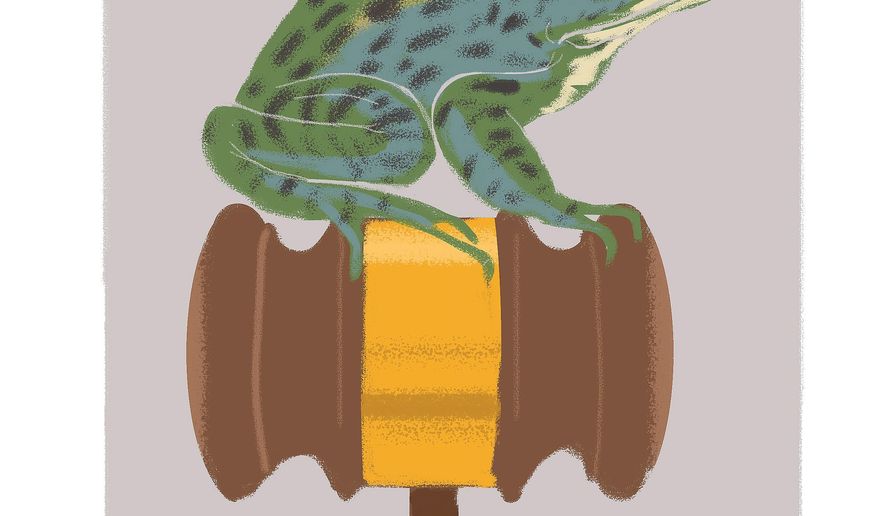OPINION:
Sherlock Holmes it isn’t. But Weyerhaeuser v. United States Fish and Wildlife Service, a case seeking review by the Supreme Court, could be called, “The Case of the Missing Frog.” In this amphibian equivalent of an Arthur Conan Doyle mystery, the government seeks to seize control of land it does not own, to protect an endangered species of frog that does not live there, force private landowners to tear down a healthy native forest, and install at landowner expense a new forest the landowner does not want.
The dusky gopher frog was known as the Mississippi Gopher Frog (after its home state) until 2012 when the Fish and Wildlife Service (FWS) began to consider taking control of Louisiana land to protect it and changed the name of the critter. Some of these frogs had once resided in Louisiana, but not, by all accounts, since 1965.
That is because to survive this frog needs land with: 1) “ephemeral ponds” (wet in the spring; dry in the summer) for breeding; 2) open canopy forests nearby maintained by frequent fires, and 3) upland habitat with abundant native herbaceous ground cover. With only the wet-dry ponds present now, the frogs cannot live in what is, according to the FWS’ official designation, its “critical habitat” in Louisiana.
As one of the petitioners to the Supreme Court, the Weyerhaeuser Company, put it in a recent brief, in order to achieve actual habitability for the frog, the FWS is telling owners of this “critical habitat” that they must take several draconian actions.
These would include chopping down their closed-canopy, loblolly pines and replacing them with open-canopied longleaf pines; burning the new forest with “frequent fires” to “support a diverse ground cover of herbaceous plants” in spite of acknowledged “landowner concern” and “negative impacts” of such fires; terminating “on-going timber management of the site, which precludes burning or planting longleaf pine trees”; allowing most or all of the land to be “managed” as refuge for the frog at a cost of tens of millions of dollars in lost development value, and agreeing to “frog translocations.”
The FWS has also said that it anticipates making more designations of “critical habitat” in the future outside any area occupied by a relevant species. In practical terms, this means that, if the lower courts’ decisions stands, the agency could pick any plot of private land anywhere in the United States, designate it a “critical habitat” regardless of whether an endangered species actually lives there and then tell the landowner exactly how the land is to be used.
With more than 1,650 species listed as endangered and listings in all 50 states and the District of Columbia, every backyard in America could end up as a “critical habitat.” Where is the limit? Consider that scientists are actively working to resurrect the woolly mammoth, an ancient relative of the Asian elephant that has been extinct for 4,000 years, and which ranged across most of northern North America. Under the FWS’ interpretation of the Endangered Species Act, much of the northern United States could be considered the woolly mammoth’s past “critical habitat.”
But here is the problem for the FWS and the hope for the rest of us: The statute has a clear and unambiguous habitability requirement. As a matter of law, a species has to be able to live there for land to be designated as “critical habitat.” It is a line of argument that the justices are likely to find compelling.
As liberal Justice Elena Kagan said shortly after her elevation to the Court, “We are all textualists now,” meaning that the actual words of a statute matter. Conservative justice Neil Gorsuch echoed that view when he recently told an attorney during oral arguments, “we don’t follow what [lawmakers are] trying to do. We follow what they do.”
That is a lesson that too many Executive Branch bureaucrats have yet to learn. As a recent Wall Street Journal editorial observed about a decision by the Securities and Exchange Commission in a securities case, “The government, which intervened in the case, argued that executive agencies can ignore the text of laws if their provisions produce an outcome anomalous or contrary to Congress’ putative purpose.”
The Supreme Court should take up Weyerhaeuser and in its ultimate decision demonstrate that the Fish and Wildlife Service should be held to the clear language of the Endangered Species Act.
Finally, given that a new administration has taken office since the actions at issue transpired, Greg Sheehan, who started as the acting head of FWS in June, should undo the rule making that produced this overreaching and destructive regulation. After The Case of the Missing Frog, it should be regulatory designations like “uninhabited critical habitats” — and the bureaucrats who came up with it — that go missing.
• Henry Miller, a physician and molecular biologist, is the Robert Wesson Fellow in Scientific Philosophy and Public Policy at Stanford University’s Hoover Institution.




Please read our comment policy before commenting.